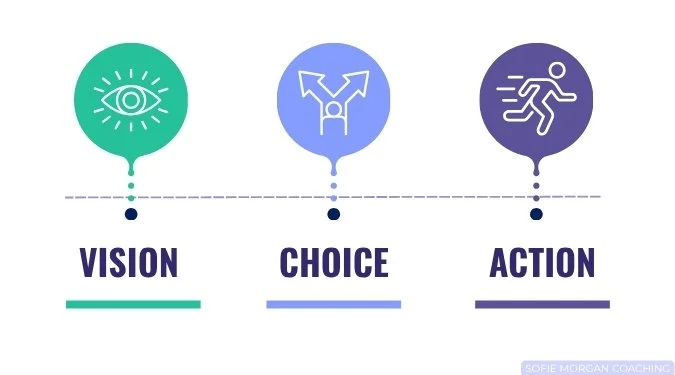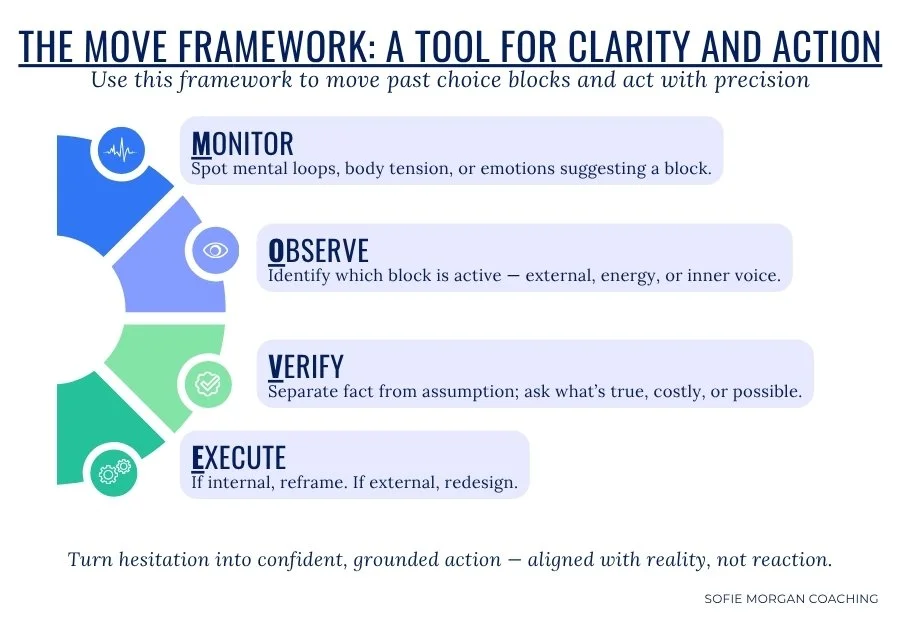The Real Reason You Get Stuck — and How to Break Through with Clarity and Momentum
Breaking Through Blocks: Vision–Choice–Action Framework
Feeling stuck doesn’t always look dramatic.
Sometimes you’re still moving — meetings, decisions, deliverables — yet something feels off. You circle the same goals without traction. You overthink next steps or keep changing direction. You’re busy, but progress feels thin.
That’s not a motivation problem. It’s a block.
Blocks aren’t failures; they’re feedback. They reveal where clarity, alignment, or energy has gotten tangled. When you learn to read that data, you can move with precision instead of pressure.
In my work with leaders, I see three recurring types of blocks: Vision, Choice, and Action.
1. Vision Blocks: When the Destination Isn’t Clear
If you don’t know where you’re headed, it’s hard to get there.
You can’t make confident choices when your vision is unclear, misaligned, fear-based, or borrowed from someone else.
Unclear: You haven’t fully imagined what success looks and feels like.
Misaligned: You’re pursuing goals that don’t reflect what truly matters.
Fear-based: You’re chasing safety or avoidance instead of growth.
Borrowed: You’re measuring success by someone else’s yardstick.
Vision blocks show up as hesitation, endless planning, or lack of motivation. When the vision doesn’t feel right, conviction fades. And without conviction, energy soon fades too.
When motivation dips, pause and ask:
“What would this look like if it were truly mine?”
Clarity builds conviction. And conviction turns motion into momentum.
2. Choice Blocks: Deciding What’s Possible
Even with a clear vision, moving from insight to action can feel unexpectedly hard.
Choice is the moment when you assess what’s possible — and decide whether to move forward.
At the point of choice, leaders often face real constraints that stall progress as well as perceived constraints that cloud judgment. The key is distinguishing which is which.
Choice blocks appear across three dimensions:
External: Real-world limits — resources, timelines, expectations.
Energy: Personal limits — fatigue, stress, bandwidth.
Inner: Mental voices and patterns — self-criticism, assumptions, or fear loops.
Inner Voices That Sabotage Choice
These internal voices often sound rational, even protective. Left unchecked, they quietly block growth.
| Voice | What It Says | Why It Shows Up | How It Holds You Back |
|---|---|---|---|
| The Critic | “You’re not doing enough.” | Protects from failure or rejection. | Traps you in pressure and self-doubt. |
| The Historian | “This always happens to you.” | Seeks safety in familiar narratives. | Blocks new possibilities. |
| The Storyteller | “They probably think you don't care.” | Tries to make sense of uncertainty. | Creates assumptions that distort reality. |
| The Comfort Seeker | “Do the usual — you’ll feel better.” | Avoid risk or discomfort. | Keeps you productive but stuck. |
These voices can lead you to mistake emotion for instinct or assumption for fact, quietly distorting reality in the process.
The first move is separating facts from fears, signals from noise, instinct from reaction.
The MOVE Framework below can help you make that distinction — and move forward.
3. Action Blocks: When the Plan Itself Stalls Progress
Even with clarity and deliberate choice, execution can falter.
You may know exactly what to do, but the plan becomes the problem.
Action blocks arise when the structure itself is unrealistic, rigid, or short-sighted.
Unmanageable steps: Too big to start, so you never begin.
Unrealistic deadlines: Pressure without progress.
Short-sighted assumptions: Overlooked dependencies create friction later.
Rigid structure: No room to adjust when reality shifts.
Even the most motivated leaders stall when the plan can’t support action. That’s not a willpower issue — it’s a design flaw.
The fix:
Break work into micro-steps that create visible progress.
Test and adjust based on reality, not assumption.
Build flexibility into your systems so they can evolve.
Momentum comes from a plan you can actually follow, not one you have to fight.
4. Building a Block-Resistant Mindset
You can’t eliminate blocks entirely, but you can shorten their lifespan.
The goal isn’t perfection; it’s agility.
Long-term reset strategies include:
Track your patterns. Notice where resistance shows up — ideation, decision, or action. Patterns reveal leverage.
Preload new scripts. Write counter-lines to familiar thought loops before they hijack momentum.
Build accountability with intention. Externalize commitments to sustain progress when motivation dips.
Cultivate curiosity. When friction appears, ask what it’s revealing instead of what’s wrong with you.
Revisit your energy influencers. Redesign environments, routines, and relationships that affect your drive.
Practice antifragility. Treat discomfort as data and training — a necessary part of developing capacity, not a sign you’re off track.
This is the work of sustainable self-leadership:
Not forcing productivity, but creating the systems and mindset where clarity and follow-through become your default.
The Bottom Line
Every block has data in it.
When you stop labeling it as resistance and start reading it as feedback, you gain leverage.
You stop spinning and start steering again.
If you’re noticing patterns you can’t seem to shift — in clarity, choices, or follow-through — it may be time for structured reflection or support.
Start with the Breaking Through Blocks Guide, a one-page tool to help you recognize, examine, clarify, and act on your next step with more precision.
👉 Download the Breaking Through Blocks Guide
Want deeper support? Contact me to learn about coaching services.

